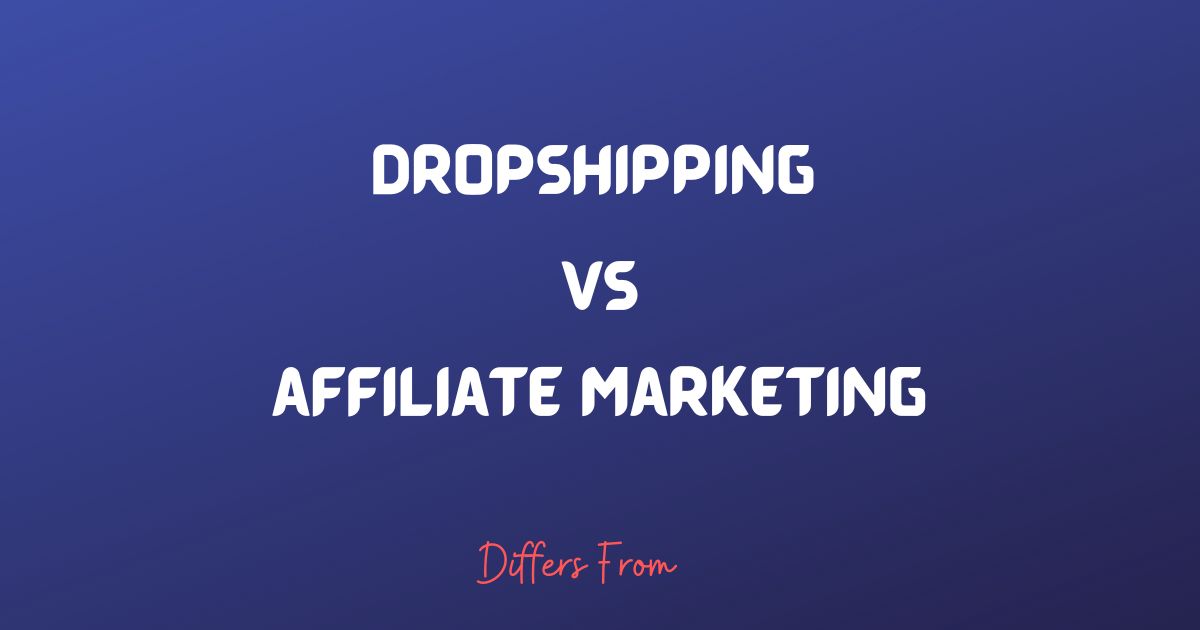Are you a budding entrepreneur torn between dropshipping and affiliate marketing? Let’s embark on a journey to explore the fascinating world of e-commerce. Discover the difference between dropshipping and affiliate marketing and unlock the key to your business success.
Drop shipping is a retail fulfillment method where a store doesn’t keep the products it sells in stock. Instead, when a store sells a product, it purchases the item from a third party and has it shipped directly to the customer.
Affiliate marketing is a marketing arrangement where an online retailer pays a commission to an external website for traffic or sales generated from its referrals.
Difference between dropshipping and affiliate marketing
Dropshipping involves selling products with no inventory, managing shipping, and customer service. Affiliate marketing focuses on promoting products for a commission, without inventory or shipping responsibilities. Dropshipping involves ownership, while affiliate marketing does not.
| Dropshipping | Affiliate marketing |
| Involves selling physical products without holding inventory | Involves promoting other people’s products for a commission |
| Involves managing the shipping and handling process | No need to hold inventory or manage shipping and handling |
| Requires upfront investment in product inventory | Requires no upfront investment in product inventory |
| Requires handling customer service issues | No need to handle customer service issues |
| May have lower profit margins but more control over pricing and product selection | May have higher profit margins but less control over pricing and product selection |
| Offers the potential for branding and building a loyal customer base | Offers the potential for flexibility and scalability |
| Requires ownership of the business and accountability for its success or failure | Does not require ownership of the business and may offer less accountability for its success or failure. |
What is Dropshipping?
Dropshipping is a business model where an online retailer sells products without keeping them in stock. Instead, when a customer orders, the retailer purchases the item from a third-party supplier who directly ships it to the customer.
The retailer acts as a middleman, handling the marketing, sales, and customer service. This allows for low startup costs and eliminates the need for inventory management.
However, the retailer typically earns lower profit margins than traditional retail due to the involvement of suppliers and shipping costs.
Features of Dropshipping
- Sell products without inventory.
- Partner with suppliers who handle shipping.
- Low startup costs and vast product selection.
- Limited control over shipping, lower profit margins.
- Location-independent and scalable.
- Potential for competition and dependency on suppliers.
Business structure and process
Finding Suppliers
Look for reputable suppliers who offer dropshipping services. Online directories, marketplaces, and industry-specific platforms can be valuable resources for finding suppliers.
Evaluate suppliers
Assess product quality, pricing, shipping options, reliability, and customer reviews. It’s essential to partner with reliable suppliers to ensure customer satisfaction.
Contact suppliers
Contact potential suppliers to discuss their dropshipping services, terms, and conditions. Inquire about their product catalog, pricing, minimum order requirements, and shipping arrangements.
Pros of Dropshipping
- Low startup costs: Dropshipping requires minimal upfront investment compared to traditional retail models. There’s no need to purchase inventory or manage a warehouse, reducing financial risks.
- No inventory management: As a dropshipper, you don’t need to handle or store inventory. Suppliers handle product storage, packaging, and shipping, saving time and resources.
- Wide product selection: With dropshipping, you can offer your customers a vast range of products without the limitations of physical inventory. This allows flexibility in adapting to market demands and testing different product offerings.
- Scalability: Dropshipping allows for easy scalability since inventory limitations do not constrain you. You can scale your business by expanding product offerings, reaching new markets, and partnering with additional suppliers.
Cons of Dropshipping
- Lower profit margins: Due to the involvement of suppliers and shipping costs, dropshippers generally have lower profit margins than retailers who hold inventory.
- Limited control over shipping and fulfillment: Since suppliers handle shipping, you need more control over the speed and quality of order fulfillment. Delays or issues with shipping can impact customer satisfaction and your business reputation.
- Dependency on suppliers: Your business relies on your suppliers’ performance and reliability. If a supplier goes out of stock or faces issues, it can disrupt your operations and affect customer satisfaction.
Learn more about dropship and wholesale on this article- Difference between Wholesale And Dropship
What is affiliate marketing?
Affiliate marketing is a performance-based business model where individuals or businesses promote products or services on behalf of a company or merchant.
Affiliates earn a commission for each sale or referral they generate through their unique affiliate links. They do not need to own or handle the products themselves.
It offers flexibility, scalability, and the potential for high commissions. Still, success relies on building a trustworthy online presence and effectively promoting affiliate products.
Features of Affiliate Marketing
Affiliate marketing offers the opportunity to earn passive income by leveraging your audience and promoting products or services that align with their interests and needs.
Business structure and process
Exploring affiliate network
Explore established affiliate networks like Amazon Associates, ShareASale, or Commission Junction. These platforms host a wide range of affiliate programs across various industries.
Identify niche-specific affiliate programs.
Look for affiliate programs directly offered by companies or merchants in your niche. Search online or reach out to brands to inquire about their affiliate opportunities.
Assess commission structures
Compare commission rates and structures among different affiliate programs. Some offer a percentage of sales, while others provide fixed fees or performance-based incentives.
Pros of Affiliate Marketing
- Passive income: Affiliate marketing allows you to earn passive income by promoting products or services and earning commissions on successful referrals or sales.
- Flexibility and scalability: You can choose your working hours and scale your affiliate marketing efforts to reach a larger audience and increase your earning potential.
- No product creation or inventory management: As an affiliate marketer, you don’t need to create or manage products. You can focus on marketing and promoting existing products or services.
Cons of Affiliate Marketing
- Dependence on affiliate programs: Your success in affiliate marketing relies on the availability and performance of affiliate programs. Changes in program policies or closures can impact your income.
- Competition and saturation: Affiliate marketing is a popular business model, leading to intense competition and saturation in particular niches. Standing out from the crowd can be challenging.
How does social media marketing help dropshipping and affiliate marketing?
Social media marketing is crucial in boosting dropshipping and affiliate marketing endeavors. Here are some ways social media marketing helps:
Instagram Influencer Collaboration
A dropshipping store specializing in fitness apparel partnered with a popular fitness influencer on Instagram. The influencer created engaging posts featuring the store’s products and provided a unique discount code for their followers. The campaign significantly increased website traffic and sales, showcasing the power of influencer marketing on social media.
Facebook Ad Campaign for Affiliate Marketing
An affiliate marketer promoting a beauty brand ran a targeted Facebook ad campaign. Using Facebook’s precise targeting options, the marketer reached users interested in beauty products and redirected them to the brand’s website using their affiliate link. The campaign generated many conversions and earned the marketer a significant commission.
Customer Engagement on Twitter
A dropshipping store selling personalized gifts actively engaged with customers on Twitter. They responded to customer inquiries, provided prompt assistance, and shared user-generated content showcasing their products. This customized engagement built customer trust and loyalty, resulting in positive word-of-mouth and increased sales.
YouTube Product Reviews
An affiliate marketer focused on technology products created detailed review videos on YouTube. They showcased the features, benefits, and personal experience with the consequences. By including affiliate links in the video description, the marketer earned commissions on each sale generated through their videos. The combination of informative content and affiliate marketing proved highly successful.
Pinterest Visual Inspiration
A dropshipping store selling home decor items utilized Pinterest to curate visually appealing boards showcasing different interior design styles. They optimized their pins with relevant keywords and linked them to their product pages. As users discovered and saved their pins, the store experienced a surge in traffic and sales from Pinterest referrals.
You can hire a professional social media manager to grow our dropshipping or affiliate business.
Conclusion
In conclusion, dropshipping and affiliate marketing are distinct business models with unique advantages and considerations. Dropshipping involves owning an online store, managing inventory, and handling customer service, while affiliate marketing focuses on promoting products for a commission without inventory or shipping responsibilities.
Dropshipping offers more control over the product and pricing but requires more upfront investment, while affiliate marketing offers flexibility and scalability.
Choosing between the two depends on factors such as investment capabilities, desired level of control, and preference for product ownership.
FAQs
Which one requires more upfront investment, dropshipping or affiliate marketing?
Answer: Dropshipping typically requires a higher upfront investment compared to affiliate marketing. In dropshipping, you must invest in product inventory, packaging materials, and a website or online store. Affiliate marketing, on the other hand, usually has little to no upfront costs since you don’t handle any inventory.
Which one offers higher profit margins, dropshipping or affiliate marketing?
Answer: Dropshipping and affiliate marketing can both offer good profit margins, but it depends on various factors. Dropshipping gives you more control over pricing, allowing you to earn higher margins. However, you also bear the costs of inventory and shipping. In affiliate marketing, you make a commission percentage of the sale price. Still, the profit margin is typically lower since the product owner sets the prices.
Which requires more time and effort, dropshipping or affiliate marketing?
Answer: Both dropshipping and affiliate marketing require time and effort but in different areas. Dropshipping requires more time and effort in managing inventory, fulfilling orders, and handling customer service. Affiliate marketing involves creating content, building an audience, and promoting products. The amount of time and effort required can vary depending on your approach and level of involvement.
Can you do both dropshipping and affiliate marketing simultaneously?
Answer: Yes, it is possible to combine dropshipping and affiliate marketing. Some dropshippers also incorporate affiliate marketing into their business model to diversify their income streams. For example, you can create content around your dropshipping products and include affiliate links to related products or accessories.
Which is better for beginners, dropshipping or affiliate marketing?
Answer: Both dropshipping and affiliate marketing have pros and cons for beginners. Dropshipping requires more upfront investment and involves more operational tasks, but it offers greater control over the business. Affiliate marketing has lower barriers to entry, requires a minimal upfront investment, and focuses more on marketing and promotion. Choosing the better option depends on your interests, skills, and resources.
Is dropshipping or affiliate marketing more scalable?
Answer: Dropshipping and affiliate marketing both offer scalability but in different ways. With dropshipping, you can scale by adding more products, expanding your customer base, and optimizing your operations. In affiliate marketing, you can scale by creating more content, reaching a larger audience, and partnering with additional affiliate programs. The scalability of each depends on your ability to adapt and grow in the respective model.
Can you switch from dropshipping to affiliate marketing or vice versa?
Answer: It is possible to switch between dropshipping and affiliate marketing. Many entrepreneurs start with one model and later transition to another based on their experience and business goals. The skills and knowledge gained in one model can often be applied to the other, making the transition smoother.

